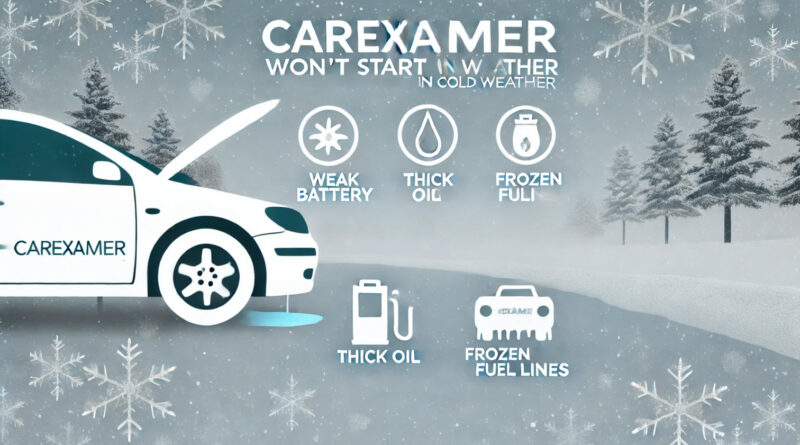Here’s Why Car Won’t Start in the Cold?
Let’s dive into the most common reasons and what you can do about them when car won’t start in the cold. There’s nothing worse than getting into your car on a freezing morning, turning the key, and hearing… nothing. Cold weather can be tough on cars, but knowing the likely causes of why your car won’t start in the cold can help you get back on the road.
1. Your Battery Might Be Dead or Weak
A dead or weak battery is probably the most common culprit when your car refuses to start in cold weather. Batteries lose power in low temperatures, making it harder to turn over the engine.
What to Look For:
- Is the engine cranking slowly?
- Do your headlights or dashboard lights seem dim?
- Hear a clicking sound when you turn the key?
What to Do:
- Check the battery voltage with a multimeter (12.24 volts min to start the car).
- Try jump-starting your car. If it works, it’s probably time to replace that battery.
- Park in a garage or use a battery warmer to keep things warm.
2. Engine Oil Could Be Too Thick
Cold weather can make your engine oil thicken up, which makes it harder for the engine to turn over. Thick oil means more resistance, which can be a problem on those chilly mornings.
What to Look For:
- The engine turns over very slowly, like it’s struggling.
What to Do:
- Make sure you’re using the right winter-grade oil (thinner oils perform better in cold weather).
- If you have an engine block heater, use it to warm things up before you start the car.
3. Fuel Lines Might Be Frozen
If you’ve got moisture in your fuel lines, it can freeze and stop the fuel from reaching the engine. No fuel, no start.
What to Look For:
- The engine cranks but doesn’t start, or it starts and stalls quickly.
What to Do:
- Keep your gas tank at least half full during the winter to prevent condensation.
- Use a fuel line antifreeze or fuel additive to keep the fuel flowing.
- If possible, move your car to a warmer spot (like a garage) to thaw things out.
4. Faulty Starter Motor
The starter motor is what gets your engine going when you turn the key. In cold weather, a weak or faulty starter might struggle to do its job.
What to Look For:
- Do you hear a clicking noise when you turn the key, but the engine doesn’t crank?
What to Do:
- Check the connections to the starter motor; make sure everything’s clean and tight.
- If the starter is the issue, you’ll need a mechanic to repair or replace it.
5. Spark Plugs Could Be Worn Out
Your spark plugs ignite the fuel in your engine. If they’re worn or dirty, they may not fire properly in cold weather.
What to Look For:
- The engine cranks but won’t start, or it starts and runs rough.
What to Do:
- Inspect your spark plugs. Clean them if they’re dirty, or replace them if they’re worn out.
6. Your Alternator Might Be the Issue
The alternator charges your battery while the car is running. If it’s not working right, the battery won’t have enough power to start the car, especially in cold weather.
What to Look For:
- The car starts, but dies shortly after, or the battery warning light comes on.
What to Do:
- Test the alternator at a mechanic’s shop. If it’s faulty, it’ll need to be replaced.
7. Moisture in the Ignition System
Cold, damp weather can cause moisture to get into the ignition system, which can prevent your car from starting.
What to Look For:
- The engine cranks but doesn’t start, or it runs rough after starting.
What to Do:
- Dry off any visible moisture from the ignition components with a clean cloth.
- Use a moisture-repelling spray like WD-40 to protect the ignition system.
8. Low Cold Cranking Amps (CCA)
Batteries have a cold cranking amps (CCA) rating, which shows how much power they can deliver in cold weather. If your battery doesn’t have a high enough CCA rating, it may not be able to start your car in freezing temperatures.
What to Do:
- Check your battery’s CCA rating and see if it’s suitable for your vehicle. If not, consider upgrading to a battery with a higher CCA.
9. Fuel Pump Problems
If your fuel pump isn’t working, fuel won’t reach the engine, and your car won’t start. Cold weather can make things worse if the fuel pump is already weak.
What to Look For:
- The engine cranks but doesn’t start, and you don’t hear the fuel pump running.
What to Do:
- Listen for the fuel pump when you turn the key. If it’s silent, you might need a new one.
10. Throttle Body Issues
In cold weather, the throttle body can get stuck or dirty, making it hard for your car to start or idle properly.
What to Look For:
- The engine struggles to start, or it starts but idles rough.
What to Do:
- Clean the throttle body or have a mechanic check it out if the problem persists.
Wrapping It Up
If your car won’t start in the cold, don’t panic. There are plenty of reasons this can happen, and most of them have simple fixes. Whether it’s a dead battery, thick oil, or frozen fuel lines, knowing the likely cause can help you get back on the road faster. And if all else fails, it’s always a good idea to call in a mechanic for a thorough check.
Buying a used VW. Buying used vauxhall, BMW, Jaguar, Ford, Volvo, Range rover, Bentley, Aston Martin, Porsche, Ferrari, Lamborghini, Maserati, Hyundai, Tesla, Honda, Pagani

